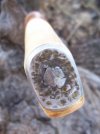Oh I didn't mean that all

I really should qualify that. You shouldn't buy a partial tang khuk and expect it to hold up AS LONG as a peened tang. It's simply not as strong as of a design obviously. However, keep in mind that probably the majority of khuks sold to Nepali villagers are partial tangs, most probably aren't even pinned like yours was. They use these things day in and day out. Eventually the blade begins to work loose, so they take it back to the kami to firm it up a bit.
In short, a pinned HI khuk might only take 3 or 4 years of chopping before it loosens up instead of a lifetime+ with a pinned tang. The blade and the tang on yours is pure HI tough. With a quality handle and pin job, it should last a good long time. It's simple a matter of physics when it comes to blade weight and handle attachment before things work loose.
In short, I would trust my life to a pinned HI khuk to get me out of a pinch without fail. However, with Murphy and his damned laws visiting me on a daily basis, a pinned khuk would not be the first khuk I would pick to take on an extended outdoor adventure. But the blade of yours is heat treated and as tough as any other HI knife. :thumbup:




